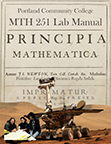Activity 7.2 Derivatives of Inverse Functions
¶Using Definition 3.3.1, it is easy to establish that \(\lzoo{x}{x^2}=2x\text{.}\) We can use this formula and implicit differentiation to find the formula for \(\lzoo{x}{\sqrt{x}}\text{.}\) If \(y=\sqrt{x}\text{,}\) then \(y^2=x\) (and \(y\geq0\)). Using implicit differentiation we have:
But \(y=\sqrt{x}\text{,}\) so we have:\(\begin{aligned}[t]\lz{y}{x}&=\frac{1}{2y}\\&=\frac{1}{2\sqrt{x}}\text{.}\end{aligned}\)
In a similar manner, we can use the fact that \(\lzoo{x}{\fe{\sin}{x}}=\fe{\cos}{x}\) to come up with a formula for \(\lzoo{x}{\fe{\sin^{-1}}{x}}\text{.}\) If \(y=\fe{\sin^{-1}}{x}\text{,}\) then \(\fe{\sin}{y}=x\) and \(-\frac{\pi}{2}\leq y\leq \frac{\pi}{2}\text{.}\) Note that because of the angle range that \(y\) is confined to, that \(\fe{\cos}{y}\) is positive. So the Pythagorean identity \(\fe{\cos^2}{y}=1-\fe{\sin^2}{y}\) implies that \(\fe{\cos}{y}=\sqrt{1-\fe{\sin^2}{y}}\text{.}\) This gives us:
Subsection Exercises
1.
Use the fact that \(\lzoo{x}{e^x}=e^x\) together with implicit differentiation to show that \(\lzoo{x}{\fe{\ln}{x}}=\frac{1}{x}\text{.}\) Begin by using the fact that \(y=\fe{\ln}{x}\) implies that \(e^y=x\) (and \(x>0\)). Your first step is to differentiate both sides of the equation \(e^y=x\) with respect to \(x\text{.}\)
2.
Use the fact that \(\lzoo{x}{\fe{\ln}{x}}=\frac{1}{x}\) together with implicit differentiation to show that \(\lzoo{x}{e^x}=e^x\text{.}\) Begin by using the fact that \(y=e^x\) implies that \(\fe{\ln}{y}=x\text{.}\) Your first step is to differentiate both sides of the equation \(\fe{\ln}{y}=x\) with respect to \(x\text{.}\)
3.
Use the fact that \(\lzoo{x}{\fe{\tan}{x}}=\fe{\sec^2}{x}\) together with implicit differentiation to show that \(\lzoo{x}{\fe{\tan^{-1}}{x}}=\frac{1}{1+x^2}\text{.}\) Begin by using the fact that \(y=\fe{\tan^{-1}}{x}\) implies that \(\fe{\tan}{y}=x\) (and \(-\frac{\pi}{2}\lt y\lt\frac{\pi}{2}\)). Your first step is to differentiate both sides of the equation \(\fe{\tan}{y}=x\) with respect to \(x\text{.}\) Please note that you will need to use the Pythagorean identity that relates the tangent and secant functions while working this problem.
